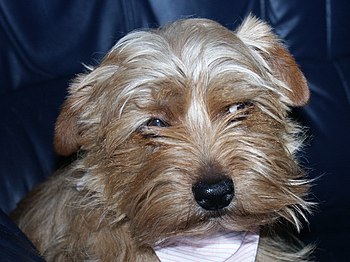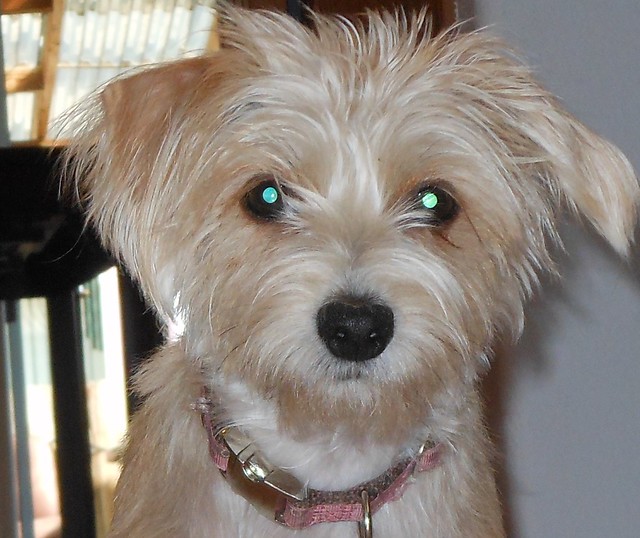The original function of breed was that of a rodent killer in the kitchens, barns, stables and granaries. Some report that the Affen was used to flush out small game, also. Over the past three centuries the Affenpinscher has become a loved family companion who is willing to be dressed up in doll clothes by the young girls and pushed around in a baby carriage. But the dog is also willing to roughhouse in the yard or go chasing a ball with the boys. The breed's flexible front quarters allow the playful pet to quickly pivot, scoop up a ball and literally toss it toward his master.
 |
| Affenpinscher - Photo: Wikimedia |
Going for long walks or sitting on the sofa watching TV with the family, the Affenpinscher adapts and thrives with all kinds of human interaction. However, children under four years old or older children who do not respect the dog's need for space and quiet time should not have an Affenpinscher. As with any small dog, uncontrolled little people can appear to be the enemy. Extra care should be taken to introduce the puppy into a family with young children.
Generally, this breed is a wonderful companion. It travels well and can accompany the family almost anywhere and by almost any means of transportation. In an adequately sized dog crate, a soft-sided doggie carrying case with a net covered opening, or any small pet carrying case, as long as his master or mistress is near, the Affen makes a quiet and easy traveling companion.
The Affenpinscher makes an alert, intelligent and amusing pet. His personality well suits his whimsical, monkey-like appearance and the twinkle in his eyes. Imagine, if you will, a dog that loves to throw and chase his own toys, using his front paws as hands. If you laugh at his antics, your Affenpinscher will perform even more enthusiastically for your entertainment. It is quite common for him to accompany his play with a great deal of enthusiastic racing around and barking, although retrieving is not something that generally comes naturally. One of the funniest things we've ever observed was an Affenpinscher attacking a wind-up stuffed dog that walked, barked and flipped over. With this in mind, child's toys are best kept out of the dog's reach, and all of the Affen's toys should be checked carefully for suitability. Toys with small parts or materials inside that could injure the dog if ingested should be avoided or allowed only with supervision.
Another characteristic of this breed is its independence, which sometimes verges on aloofness. The Affenpinscher has a great sense of its own self-importance, which is comical in a breed so small and endearingly bedraggled.
This delightful little creature also makes an excellent watchdog, barking vociferously as his first line of defense if he feels his territory is being invaded (even by the postman). Originally bred to guard his domain from intruders, be they rodent, canine or human, an Affenpinscher will still defend his property (including his owners) fearlessly.
It is likely that the Affenpinscher will bond most closely to one member of your family. While he is generally a quiet and affectionate companion, he is likely to become extremely excited and aggressive if he perceives that he or his owners are being attacked. This means that you should be careful when introducing your pet to visitors, and make sure that he understands that they are welcome in his home. Speak to your dog softly and soothingly, and allow him to approach your visitors when he is ready, rather that forcing their attentions on him. He may feel insecure or become frightened if a stranger bends down to pet him. It is also not a good idea for a stranger to stare directly into your Affenpinscher's eyes, as he may interpret this as a challenge.
Although Affenpinschers do have a terrier-like personality, they generally tend to get along with other dogs and pets (except for hamsters, guinea pigs and other rodent or rodent-like to view as prey). This is especially true if they have been raised with other animals. However, you should expect that your Affenpinscher will want to monopolize all of your attention, pushing his way in if you are playing with or petting one of your other pets. Because your Affenpinscher might attack a strange dog that he perceives as a threat, even one much larger than he is, it is important to keep him on his leash in public places. Keeping him on leash is also important for preventing him from running off after something that incites his interest, possibly into danger.
The same characteristics that make the Affenpinscher such a good watching dog mean that he generally is not a suitable breed for people with small children, although there are exceptions to this rule. Affenpinschers tend to guard their food and toys and may nip a child who attempts to take something they see as their property or who pesters them when they are sleeping or otherwise occupied. It is best if youngsters outside the family be told not to pet your Affenpinscher, as he might feel threatened and snap at them. Although generally he will not bite hard enough to break the skin, he definitely will set limits on how much he allows himself to be handled. Children should also be discouraged from picking up your dog, as he might be injured if accidentally dropped. Additionally, a small child who is flailing his arms and legs about, screaming or running away might be perceived as prey by this breed, and an Affenpinscher will certainly go after what he thinks is prey.
Because of his small size, the Affenpinscher is well suited to indoor life, even in a small apartment. The Affenpinscher thrives on the company of his human companions and tends to stay close to his owners, whether indoors or outside on a country walk (though he must be on leash for safely). This is not a dog meant to be left in the yard for hours on end or in a kennel. In fact, because he is such a great climber, he is likely to attempt to escape from any such confinement. If you use a pen or metal crate during house-training or to confine your dog when you are away, be certain that the pen or crate has a tight-fitting lid. We once knew a dog that hanged himself by pushing his head through a loose corner at the top of a pen and then was unable to get back down or out.
Affenpinschers living indoors, as they should, do not become acclimated to winter temperatures. Therefore, when walking your Affenpinscher outdoors in cold weather, be sure to provide him with a warm jacket. Quality pet-supply shops will have a variety of "winter-wear" for your stylish Affenpinscher.
Article Source: EzineArticls |

















